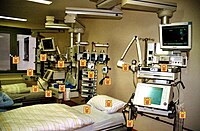
Photo from wikipedia
BACKGROUND Device-associated healthcare-acquired infections (DA-HAI) pose a threat to patient safety in the intensive care unit (ICU). METHODS A DA-HAI surveillance study was conducted by the International Nosocomial Infection Control… Click to show full abstract
BACKGROUND Device-associated healthcare-acquired infections (DA-HAI) pose a threat to patient safety in the intensive care unit (ICU). METHODS A DA-HAI surveillance study was conducted by the International Nosocomial Infection Control Consortium (INICC) in two adult medical/surgical ICUs at two hospitals in Caracas, Venezuela, in different periods from March 2008 to April 2015, using the US Centers for Disease Control and Prevention's National Healthcare Safety Network (CDC/NHSN) definitions and criteria, and INICC methods. RESULTS We followed 1041 ICU patients for 4632 bed days. Central line-associated bloodstream infection (CLABSI) rate was 5.1 per 1000 central line days, ventilator-associated pneumonia (VAP) rate was 7.2 per 1000 mechanical ventilator days, and catheter-associated urinary tract infection (CAUTI) rate was 3.9 per 1000 urinary catheter days, all similar to or lower than INICC rates (4.9 [CLABSI]; 16.5 [VAP]; 5.3 [CAUTI]), and higher than CDC/NHSN rates (0.8 [CLABSI]; 1.1 [VAP]; and 1.3 [CAUTI]). Device utilization ratios were higher than INICC and CDC/NHSN rates, except for urinary catheter, which was similar to INICC. Extra length of stay was 8 days for patients with CLABSI, 9.6 for VAP and 5.7 days for CAUTI. Additional crude mortality was 3.0% for CLABSI, 4.4% for VAP, and 16.9% for CAUTI. CONCLUSIONS DA-HAI rates in our ICUs are higher than CDC/NSHN's and similar to or lower than INICC international rates.
Journal Title: International health
Year Published: 2017
Link to full text (if available)
Share on Social Media: Sign Up to like & get
recommendations!